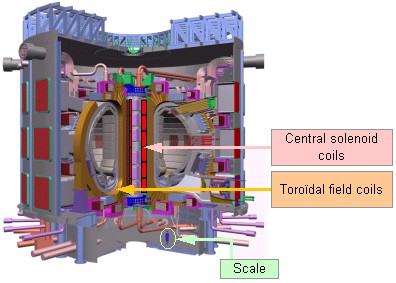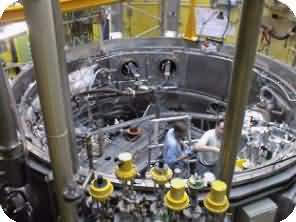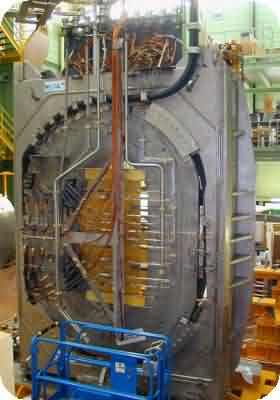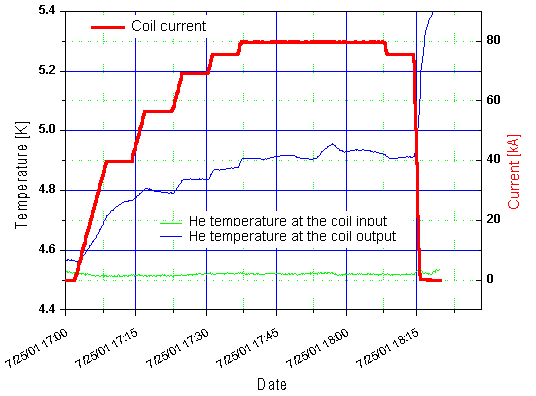|
Tests of the ITER toroidal field coil model (07-09/2001)
|
Within the framework of ITER
R&D, two superconducting model coils were built, scaled down
representative version of the coils making up the tokamak magnetic system. Using a scale 1 conductor, they are the biggest magnets built to date with a ’’cable-in
conduit’’ type conductor and niobium-tin as supra-conducting material (figures 1 and 2).
Figure 1 : schematic view of ITER |
 |
|
The Central Solenoid Model Coil
(CSMC), originally designed at CEA, was jointly built by the United States and Japan and tested successfully in 2000. This coil, of a total weight of
about a hundred metric ton,s contains 21 tons of niobium-tin, comparable to one of the 6 coils in the Central Solenoid, which will each contain 15
tons of niobium-tin. Powered by a current which has reached 46 kA in 30 secs, it produced a magnetic field of 13 teslas on the conductor.
The
Toroidal Field
Model Coil (TFMC),
representative of the toroidal magnet coils and designed at CEA, was built in Europe and underwent a first phase of tests in 2001 in Karlsruhe in Germany (figure 3). This coil, weighing a total of 40 metric
tons, contains 4 tons of niobium-tin, must be compared with the 18 coils in the toroidal magnet, which each weigh 290
tons and will each contain 19 tons of niobium-tin.

Figure 3 : Installation of the ITER TFMC in the test station TOSKA
|

Figure 2 : The ITER TFMC coil assembled
This coil worked perfectly at 80 kA, which was first
obtained on July 25th 2001. This value, representative of the nominal current of
the ITER coils, produces a maximum magnetic field of 7,8 teslas on the conductor and
allows an exploration of operating margins (figure 4). The analysis of measurements carried out during these tests led to the demonstration that electromagnetic, thermo-hydraulic and mechanical properties
correspondant to those forecast. A second phase of tests of this coil, coupled with another supra-conducting coil,
will take place in 2002, thus simulating the operation of a coil within the toroidal magnet. |

Figure 3 : First climb to 80 kA for the ITER TFMC coil
(July 25th 2001)
One of the main goals in making this coil was to qualify
the manufacturing methods. Many innovations are indeed included in its design, particularly in the use of a circular cable-in-conduit type conductor with central channel and twin-box type connections, both concepts having been developed
at CEA. Another original aspect is the insertion of a narrow sheath conductor into a rigid mechanical structure, made up of steel plates, which, combined with the use of niobium-tin, required the development of
specific fabrication process.
The construction of the ITER TFMC was led by a European consortium bringing together the companies Alstom (France), Ansaldo (Italy), Accel (Germany) and Noell (Germany) and involving several other sub-contracting companies. Thus, the supra-conducting material niobium-tin was provided by the Italian company Europa Metalli, which also carried out full implementation of the conductor, the winding having been subsequently carried out by the Italian company Ansaldo, while the delicate finishing of the steel plates was
carried out by the French company Mécachrome, with the final assembly of components left to Alstom.
Follow-up of manufacture of this coil was done mainly by the European Fusion programme coordinating team (EFDA), with the help of CEA representatives. Several other European laboratories also co-operate in this programme : EPFL/CRPP, (Switzerland), ENEA, Politecnico Torino (Italy), FZK (Germany), Twente University(The Netherlands), each making a specific contribution such as scale 1 tests of conductor samples, conductor manufacturing follow-up, measurements on supra-conducting strands, thermo-hydraulic analyses and coil tests. It is worthy of note that, if FZK and CEA were mainly responsible for testing, representatives from ENEA and Politecnico Torino also participated, as did American and Japanese representatives within the framework of
the international collaboration for ITER.
See also :
 Results of the first tests on the ITER toroidal magnet conductor.
(07-09/2001) Results of the first tests on the ITER toroidal magnet conductor.
(07-09/2001)
|
|